Exchange Currency
Swiss franc
The franc is the currency and legal tender of Switzerland and Liechtenstein; it is also legal tender in the Italian exclave Campione d’Italia. Although not formally legal tender in the German exclave Büsingen (the sole legal currency is the euro), it is in wide daily use there. The Swiss National Bank issues banknotes and the federal Swissmint issues coins.
The Swiss franc is the only version of the franc still issued in Europe. The smaller denomination, a hundredth of a franc, is a Rappen (Rp.) in German, centime (c.) in French, centesimo (ct.) in Italian, and rap (rp.) in Romansh. The ISO code of the currency used by banks and financial institutions is CHF, although „Fr.” is used by most businesses and advertisers; some use SFr.; the Latinate „CH” stands for Confoederatio Helvetica.
Given the quadrilingual populace, coins are language-neutral. Only Latin, as the last commonly spoken language on the territory of Switzerland, is used for inscriptions.
In 1798, the Helvetic Republic introduced a currency based on the Berne thaler, subdivided into 10 batzen or 100 rappen. The Swiss franc was equal to 6¾ grams pure silver or 1½ French francs. This franc was issued until the end of the Helvetic Republic in 1803, but served as the model for the currencies of several cantons in the re-formed Swiss Confederacy.
Although 22 cantons and half-cantons issued coins between 1803 and 1850, less than 15% of the money in circulation in Switzerland in 1850 was locally produced, with the rest being foreign, mainly brought back by mercenaries. In addition, some private banks also started issuing the first banknotes, so that in total, at least 8000 different coins and notes were in circulation at that time, making the monetary system extremely complicated.
In order to solve this problem, the new Swiss Federal Constitution of 1848 specified that the Federal Government would be the only entity allowed to make money in Switzerland. This was followed two years later by the first Federal Coinage Act, passed by the Federal Assembly on 7 May 1850, which introduced the franc as the monetary unit of Switzerland. The franc was introduced at par with the French franc. It replaced the different currencies of the Swiss cantons, some of which had been using a franc which was worth 1½ French francs.
In 1865, France, Belgium, Italy, and Switzerland formed the Latin Monetary Union, wherein they agreed to value their national currencies to a standard of 4.5 grams of silver or 0.290322 grams of gold. Even after the monetary union faded away in the 1920s and officially ended in 1927, the Swiss franc remained on that standard until 1936, when it suffered its sole devaluation, on 27 September during the Great Depression. The currency was devalued by 30% following the devaluations of the British pound, U.S. dollar and French franc. In 1945, Switzerland joined the Bretton Woods system and pegged the franc to the U.S. dollar at a rate of $1 = 4.30521 francs. This was changed to $1 = 4.375 francs in 1949.
Between mid-2003 and mid-2006, the franc’s exchange rate with the euro had been stable at a value of about 1.55 CHF per euro, so that the Swiss franc has risen and fallen in tandem with the euro against the U.S. dollar and other currencies. In March 2008 the Swiss franc traded above one U.S. dollar for the first time. In March 2011 it has climbed past the $1.10 mark.
The Swiss franc has historically been considered a safe-haven currency with virtually zero inflation and a legal requirement that a minimum of 40% be backed by gold reserves. However, this link to gold, which dates from the 1920s, was terminated on 1 May 2000 following a referendum. By March 2005, following a gold selling program, the Swiss National Bank held 1,290 tonnes of gold in reserves which equated to 20% of its assets
Both world wars only had a small effect on the Swiss coinage, with brass and zinc coins temporarily being issued. In 1931, the size of the 5 franc coin was reduced from 25 grams to 15, with the silver content reduced to .835 fineness. The next year, nickel replaced cupro-nickel in the 5 and 10 rappen.
In the late 1960s, due to their linkage to the devaluing U.S. dollar, the prices of internationally traded commodities rose significantly. A silver coin’s material value exceeded its monetary value, and many were being sent abroad for melting, which prompted the federal government to make this practice illegal. The statute was of little effect, and the melting of francs only subsided when the collectible value of the remaining francs again exceeded their material value.
The 1 rappen coin was still produced until 2006, albeit in ever decreasing quantities, but it did not play any great role in the monetary economy in the fourth quarter of the twentieth century (circa 1975 to 2000). People and groups who could justify the use of 1 rappen coins for monetary purposes could obtain them at face value; any other user (such as collectors) had to pay an additional 4 rappen per coin to cover the production costs, which had exceeded the actual face value of the coin for many years. The coin fell into disuse in the late 1970s and early 1980s but was only officially fully withdrawn from circulation and declared to be no longer legal tender as of 1 January 2007. The long-forgotten 2 rappen coin, not minted since 1974, was demonetized 1 January 1978.
The designs of the coins have changed very little since 1879. Among the notable changes were new designs for the 5 franc coins in 1888, 1922, 1924 (minor) and 1931 (mostly just a size reduction). A new design for the bronze coins was used from 1948. Coins depicting a ring of stars (such as the 1 franc coin seen beside this paragraph) were modified from 22 stars to 23 stars in 1983; since the stars represent the Swiss cantons, it was updated to represent the 1979 expansion of the Swiss federation, when Jura seceded from the Canton of Bern and became the 23rd canton.
The 10 rappen coins from 1879 onwards (except the years 1918–19 and 1932–39) have had the same composition, size and design until now (2011) and are still legal tender and found in circulation.
All Swiss coins are language-neutral (at least with respect to Switzerland’s four national languages), featuring only numerals, the abbreviation „Fr.” for franc, and the Latin phrases „Helvetia”, „Confœderatio Helvetica” (depending on the denomination) or the inscription „Libertas” (roman goddess of liberty) on the small coins. The name of the artist is present on the coins with the standing Helvetia and the herder.
In addition to these general circulation coins, numerous series of commemorative coins have been issued, as well as silver and gold coins. These coins are no more legal tender, but can be exchanged for face value at post offices, and at national and cantonal banks. Their material or collector’s value equals or exceeds their face value.
Eight series of banknotes have been printed by the National Bank, six of which have been released for use by the general public. The sixth series from 1976, designed by Ernst and Ursula Hiestand, depicted persons from the world of science. It has been recalled and replaced and will lose any value on 1 May 2020. As of 2010, a large number of notes from this series have not yet been exchanged, even though they have not been legal tender for more than 10 years; for example, the value of those 500 franc banknotes still in circulation represents 129.9 million Swiss francs.
The seventh series was printed in 1984, but kept as a „reserve series”, ready to be used if, for example, wide counterfeiting of the current series suddenly happened. When the Swiss National Bank decided to develop new security features and to abandon the concept of a reserve series, the details of the seventh series were released and the printed notes were destroyed.
The current, eighth series of banknotes was designed by Jörg Zintzmeyer around the theme of the arts and released starting in 1995. In addition to a new design, this series was different from the previous one on several counts. Probably the most important difference from a practical point of view was that the seldom-used 500 franc note was replaced by a new 200 franc note; this new note has indeed proved more successful than the old 500 franc note.
The base colours of the new notes were kept similar to the old ones, except that the 20 franc note was changed from blue to red to prevent a frequent confusion with the 100 franc note, and that the 10 franc note was changed from red to yellow. The size of the notes was changed as well, with all notes from the 8th series having the same height (74 mm), while the widths were changed as well, still increasing with the value of the notes. The new series contains many more security features than the previous one; many (but not all) of them are now visibly displayed and have been widely advertised, in contrast with the previous series for which most of the features were kept secret.
The Swiss franc is the only version of the franc still issued in Europe. The smaller denomination, a hundredth of a franc, is a Rappen (Rp.) in German, centime (c.) in French, centesimo (ct.) in Italian, and rap (rp.) in Romansh. The ISO code of the currency used by banks and financial institutions is CHF, although „Fr.” is used by most businesses and advertisers; some use SFr.; the Latinate „CH” stands for Confoederatio Helvetica.
Given the quadrilingual populace, coins are language-neutral. Only Latin, as the last commonly spoken language on the territory of Switzerland, is used for inscriptions.
Summary info
Summary information about Swiss franc- ISO 4217 Code:
- CHF
- Currency sign:
- CHF or SFr.
- Country:
- Switzerland, Liechtenstein, Campione d’Italia
- Subunit:
- centime
- Coins:
- ½ francs, 1 franc, 2 francs, 5 francs
- Banknotes:
- 10 Swiss francs, 20 Swiss francs, 50 Swiss francs, 100 Swiss francs, 200 Swiss francs, 1000 Swiss francs
- Central bank:
- Swiss National Bank
History
Before 1798, about 75 entities were making coins in Switzerland, including the 25 cantons and half-cantons, 16 cities, and abbeys, resulting in about 860 different coins in circulation, with different values, denominations and monetary systems.In 1798, the Helvetic Republic introduced a currency based on the Berne thaler, subdivided into 10 batzen or 100 rappen. The Swiss franc was equal to 6¾ grams pure silver or 1½ French francs. This franc was issued until the end of the Helvetic Republic in 1803, but served as the model for the currencies of several cantons in the re-formed Swiss Confederacy.
Although 22 cantons and half-cantons issued coins between 1803 and 1850, less than 15% of the money in circulation in Switzerland in 1850 was locally produced, with the rest being foreign, mainly brought back by mercenaries. In addition, some private banks also started issuing the first banknotes, so that in total, at least 8000 different coins and notes were in circulation at that time, making the monetary system extremely complicated.
In order to solve this problem, the new Swiss Federal Constitution of 1848 specified that the Federal Government would be the only entity allowed to make money in Switzerland. This was followed two years later by the first Federal Coinage Act, passed by the Federal Assembly on 7 May 1850, which introduced the franc as the monetary unit of Switzerland. The franc was introduced at par with the French franc. It replaced the different currencies of the Swiss cantons, some of which had been using a franc which was worth 1½ French francs.
In 1865, France, Belgium, Italy, and Switzerland formed the Latin Monetary Union, wherein they agreed to value their national currencies to a standard of 4.5 grams of silver or 0.290322 grams of gold. Even after the monetary union faded away in the 1920s and officially ended in 1927, the Swiss franc remained on that standard until 1936, when it suffered its sole devaluation, on 27 September during the Great Depression. The currency was devalued by 30% following the devaluations of the British pound, U.S. dollar and French franc. In 1945, Switzerland joined the Bretton Woods system and pegged the franc to the U.S. dollar at a rate of $1 = 4.30521 francs. This was changed to $1 = 4.375 francs in 1949.
Between mid-2003 and mid-2006, the franc’s exchange rate with the euro had been stable at a value of about 1.55 CHF per euro, so that the Swiss franc has risen and fallen in tandem with the euro against the U.S. dollar and other currencies. In March 2008 the Swiss franc traded above one U.S. dollar for the first time. In March 2011 it has climbed past the $1.10 mark.
The Swiss franc has historically been considered a safe-haven currency with virtually zero inflation and a legal requirement that a minimum of 40% be backed by gold reserves. However, this link to gold, which dates from the 1920s, was terminated on 1 May 2000 following a referendum. By March 2005, following a gold selling program, the Swiss National Bank held 1,290 tonnes of gold in reserves which equated to 20% of its assets
Coins
In 1850, coins were introduced in denominations of 1, 2, 5, 10, and 20 rappen and ½, 1, 2, and 5 francs, with the 1 and 2 rappen struck in bronze, the 5, 10, and 20 rappen in billon, and the franc denominations in .900 fine silver. Between 1860 and 1863, .800 fine silver was used, before the standard used in France of .835 fineness was adopted for all silver coins except the 5 francs (which remained .900 fineness) in 1875. In 1879, billon was replaced by cupro-nickel in the 5 and 10 rappen and by nickel in the 20 rappen.Both world wars only had a small effect on the Swiss coinage, with brass and zinc coins temporarily being issued. In 1931, the size of the 5 franc coin was reduced from 25 grams to 15, with the silver content reduced to .835 fineness. The next year, nickel replaced cupro-nickel in the 5 and 10 rappen.
In the late 1960s, due to their linkage to the devaluing U.S. dollar, the prices of internationally traded commodities rose significantly. A silver coin’s material value exceeded its monetary value, and many were being sent abroad for melting, which prompted the federal government to make this practice illegal. The statute was of little effect, and the melting of francs only subsided when the collectible value of the remaining francs again exceeded their material value.
The 1 rappen coin was still produced until 2006, albeit in ever decreasing quantities, but it did not play any great role in the monetary economy in the fourth quarter of the twentieth century (circa 1975 to 2000). People and groups who could justify the use of 1 rappen coins for monetary purposes could obtain them at face value; any other user (such as collectors) had to pay an additional 4 rappen per coin to cover the production costs, which had exceeded the actual face value of the coin for many years. The coin fell into disuse in the late 1970s and early 1980s but was only officially fully withdrawn from circulation and declared to be no longer legal tender as of 1 January 2007. The long-forgotten 2 rappen coin, not minted since 1974, was demonetized 1 January 1978.
The designs of the coins have changed very little since 1879. Among the notable changes were new designs for the 5 franc coins in 1888, 1922, 1924 (minor) and 1931 (mostly just a size reduction). A new design for the bronze coins was used from 1948. Coins depicting a ring of stars (such as the 1 franc coin seen beside this paragraph) were modified from 22 stars to 23 stars in 1983; since the stars represent the Swiss cantons, it was updated to represent the 1979 expansion of the Swiss federation, when Jura seceded from the Canton of Bern and became the 23rd canton.
The 10 rappen coins from 1879 onwards (except the years 1918–19 and 1932–39) have had the same composition, size and design until now (2011) and are still legal tender and found in circulation.
All Swiss coins are language-neutral (at least with respect to Switzerland’s four national languages), featuring only numerals, the abbreviation „Fr.” for franc, and the Latin phrases „Helvetia”, „Confœderatio Helvetica” (depending on the denomination) or the inscription „Libertas” (roman goddess of liberty) on the small coins. The name of the artist is present on the coins with the standing Helvetia and the herder.
In addition to these general circulation coins, numerous series of commemorative coins have been issued, as well as silver and gold coins. These coins are no more legal tender, but can be exchanged for face value at post offices, and at national and cantonal banks. Their material or collector’s value equals or exceeds their face value.
Banknotes
In 1907, the Swiss National Bank took over the issuance of banknotes from the cantons and various banks. It introduced denominations of 50, 100, 500 and 1000 francs. 20 franc notes were introduced in 1911, followed by 5 franc notes in 1913. In 1914, the Federal Treasury issued paper money in denominations of 5, 10 and 20 francs. These notes were issued in three different versions: French, German and Italian. The State Loan Bank also issued 25 franc notes that year. In 1952, the National Bank ceased issuing 5 franc notes but introduced 10 franc notes in 1955. In 1996, 200 franc notes were introduced whilst the 500 franc note was discontinued.Eight series of banknotes have been printed by the National Bank, six of which have been released for use by the general public. The sixth series from 1976, designed by Ernst and Ursula Hiestand, depicted persons from the world of science. It has been recalled and replaced and will lose any value on 1 May 2020. As of 2010, a large number of notes from this series have not yet been exchanged, even though they have not been legal tender for more than 10 years; for example, the value of those 500 franc banknotes still in circulation represents 129.9 million Swiss francs.
The seventh series was printed in 1984, but kept as a „reserve series”, ready to be used if, for example, wide counterfeiting of the current series suddenly happened. When the Swiss National Bank decided to develop new security features and to abandon the concept of a reserve series, the details of the seventh series were released and the printed notes were destroyed.
The current, eighth series of banknotes was designed by Jörg Zintzmeyer around the theme of the arts and released starting in 1995. In addition to a new design, this series was different from the previous one on several counts. Probably the most important difference from a practical point of view was that the seldom-used 500 franc note was replaced by a new 200 franc note; this new note has indeed proved more successful than the old 500 franc note.
The base colours of the new notes were kept similar to the old ones, except that the 20 franc note was changed from blue to red to prevent a frequent confusion with the 100 franc note, and that the 10 franc note was changed from red to yellow. The size of the notes was changed as well, with all notes from the 8th series having the same height (74 mm), while the widths were changed as well, still increasing with the value of the notes. The new series contains many more security features than the previous one; many (but not all) of them are now visibly displayed and have been widely advertised, in contrast with the previous series for which most of the features were kept secret.
CHF banknotes pictures gallery
| 10 Swiss francs | |
|---|---|
| Banknote of 10 Swiss francs has dimensions 126×74 mm and main colors are indian yellow, cordovan, pastel blue, ruddy brown, fawn, earth yellow and pale gold. Date of issue of 10 Swiss francs banknote was 8 April 1997. | |
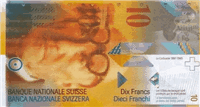 Obverse side of the 10 Swiss francs is showing the portrait of Charles Edourd Jaenneret, better known as Le Corbusier (1887-1965), one of the outstanding masters of modern design. Le Corbusier was an architect, town planner, urbanist, painter and theoretician whose creative energies focused on the human being. This orientation is expressed, above all, in his pioneering concepts of residential design and urban planning. Le Corbusier used skeleton construction and prefabrication techniques in an innovative industrial approach to building – for example in the government complex in Chandigarh, India. Moreover, he influenced modern design and gained international recognition as a designer of furniture and as an architect of sacred buildings, for example the famous pilgrim church of Notre-Dame-du-Haut in Ronchamp. |
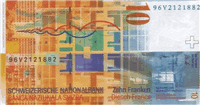 Reverse side of the 10 Swiss francs is showing
|
| 20 Swiss francs | |
|---|---|
| Banknote of 20 Swiss francs has dimensions 137×74 mm and main colors are tuscan red, caput mortuum, turkish rose, deep chestnut and opera mauve. Date of issue of 20 Swiss francs banknote was 1 October 1996. | |
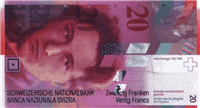 Obverse side of the 20 Swiss francs is showing the portrait of Arthur Honegger (1892-1955), one of this century’s greatest composers. The broad-ranging work of this Swiss composer includes two operas, five symphonies, several orchestral works, various dramatic oratorios and a large body of chamber music. In addition to his famous symphony for the steam locomotive „Pacific 231” (the elements on the reverse of the banknote refer to this work), Honegger wrote extensively in a lighter vein for the ballet, stage and film. The strict formalism and clarity of his musical idiom, with which he hoped to reach a very wide audience, is an important bridge between German and French speaking culture. |
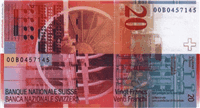 Reverse side of the 20 Swiss francs is showing
|
| 50 Swiss francs | |
|---|---|
| Banknote of 50 Swiss francs has dimensions 74×148 mm and main colors are khaki, myrtle, dark jungle green, old lavender and feldgrau. Date of issue of 50 Swiss francs banknote was 3 October 1995. | |
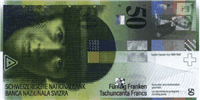 Obverse side of the 50 Swiss francs is showing the portrait of Sophie Taeuber-Arp (1889-1943), one of the outstanding abstract artists of this century. Her work includes painting, textiles, sculptures and reliefs. Dance and theater were also among the artist’s favored media expression. Circular, line and rectangular compositions, as well as the famous „Dada heads”, are typical of this work, as shown on the back of the note. Sophie Taeuber-Arp, who spearheaded new artistic movements, is one of the key figures in modern art. |
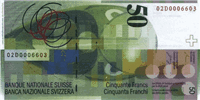 Reverse side of the 50 Swiss francs is showing
|
| 100 Swiss francs | |
|---|---|
| Banknote of 100 Swiss francs has dimensions 159×74 mm and main colors are air force blue, glaucous, pastel blue, pale cornflower blue, old lavender and gainsboro. Date of issue of 100 Swiss francs banknote was 1 October 1998. | |
 Obverse side of the 100 Swiss francs is showing the portrait of Alberto Giacometti (1901-1966), one of the 20th century’s most important sculptors. Giacometti made his reputation in the thirties, with sculptural works in the Surrealist style. But it was his later figures that brought him wider frame. The characteristic Giacometti style first appeared in 1946: attenuated figures which seem almost massless and weightless. The female figures are seen frontally, with feet together, arms pressed to their sides and clump-like feet. The males are usually striding. The figures seem solitary and somehow far-off. In his work Giacometti was trying to render complexity and the brimming experiences of reality. This is also apparent in his painting, which is highly expressive and stripped of all illusion. |
 Reverse side of the 100 Swiss francs is showing
|
| 200 Swiss francs | |
|---|---|
| Banknote of 200 Swiss francs has dimensions 170×74 mm and main colors are raw umber, sand, desert sand, shadow, khaki and wild blue yonder. Date of issue of 200 Swiss francs banknote was 1 October 1997. | |
 Obverse side of the 200 Swiss francs is showing the portrait of Charles Ferdinand Ramuz (1878-1947), one of the major French-speaking Swiss authors of the 20th century. His extensive literary œvre includes novels, essays, poetry, theoretical writings and treatises on the music of Igor Stravinsky. Ramuz’ work is characterized by a profound commitment to the truth and strict aesthetic standards. At the center of his writings is man with all his hopes and wishes. Magnificently depicted landscapes serve as the backdrop, in which mountainous regions and lakes have a special place. In formal terms, Ramuz modernized the novel by using new expressive techniques borrowed from painting and the cinema. |
 Reverse side of the 200 Swiss francs is showing
|
| 1000 Swiss francs | |
|---|---|
| Banknote of 1000 Swiss francs has dimensions 181×74 mm and main colors are regalia, purple heart, dark lavender and cinereous. Date of issue of 1000 Swiss francs banknote was 1 April 1998. | |
 Obverse side of the 1000 Swiss francs is showing the portrait of Jacob Burckhardt (1818-1897), one of the most distinguished German-speaking historians of culture of the 19th century. He is famous primarily for his well-founded and artistically sensitive interpretation of the Italian Renaissance and his guide to the art treasures of Italy, a work that has become a classic. Burckhardt’s life work forms the basis for the modern scientific study of art history. His concept of the Renaissance has shaped our understanding of the modern age until today. As a historian, Jacob Burckhardt applied his literary skill to historiography, and his work is considered a classic of academic prose. In particular, he described the main currents in comparable periods which remained constant over time. Instead of presenting a linear description of history, Burckhardt approached the task from a cross-cultural perspective. |
 Reverse side of the 1000 Swiss francs is showing
|
Useful links
- About Swiss National Bank:
- Swiss National Bank
- List of currencies:
- Currencies
- Security and design features of CHF banknotes:
- CHF banknotes
- CHF currency on Wikipedia:
- Swiss franc
- Official Website of Swiss National Bank:
- www.snb.ch
- Commemorative coins:
- Commemorative Coins